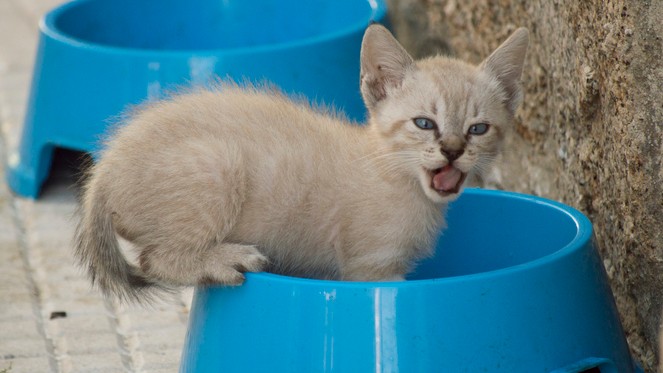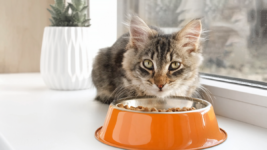Food isn’t only designed to be tasty – it should also provide the essential ingredients needed to ensure your kitten has a great start in life. To that end, you should, at the very least, select the best kitten food as soon as a kitten has been transitioned from their mother’s milk at around four weeks old. At that point, kittens will begin to rely on the diet you provide for their vitamins, minerals, and overall nutrition.
One thing’s for sure, you need to treat kittens differently to adult cats. In the first year of life, a kitten needs a specific formula to support its growth and development. It’s also important to approach the feeding of kittens carefully and responsibly. With that in mind, we’ve asked expert vet Dr Catherine Barnette to share six kitten feeding tips (and what not to do). You can also find out more about raising a young cat by checking out our top six kitten care tips.
Top six kitten feeding tips for raising a strong and healthy cat
1. Slowly introduce new foods
Whether you are weaning a kitten or you’ve decided to switch to a different food, any changes must be made slowly. “Gradual transitions give your kitten a chance to acclimate to new food,” Dr Barnette says.
To avoid a kitten going on hunger strike – and to prevent the development of diarrhea or other gastrointestinal signs in response to a food change – offer a blend of old and new foods for about a week.
“On day one, add a very small amount of your kitten’s new food to a bowl of the old food,” Dr Barnette advises. “Then, each day, increase the quantity of new food while decreasing the quantity of old food. By mid-week, you should be feeding a 50-50 mixture of the old and new food. At the end of the week, you can completely eliminate the old food and solely feed the new diet.”
2. Feed a nutritionally complete, balanced diet
When we assess the best kitten food, we go to great lengths to ensure it provides complete and balanced nutrition appropriate for a cat’s required life stage. In doing so, we know that the task isn’t an easy one: pet food labels can be complex and difficult to read which means it’s sometimes hard to distinguish fact from marketing hype.
When evaluating a diet, Dr Barnette suggests paying careful attention to the food’s Nutritional Adequacy Statement which will be printed on the label, as described by the Association of American Feed Control Officials. A typical Nutritional Adequacy Statement for a balanced kitten food may tell you that a certain brand of cat food “provides complete and balanced nutrition for kittens.” In that case, you can be more confident that it’s appropriate.
“It’s important to feed a diet that is complete and balanced for kittens,” Dr Barnette affirms. “A diet that is intended solely for adult cats will not meet the needs of a growing kitten.”
3. Monitor your kitten’s appetite
You can’t just feed a kitten and walk away, feeling as if the job is done. Kittens are extremely active, and they need many calories to fuel their high-energy play. “It’s important to monitor your kitten’s food intake and make sure he or she is eating enough,” Dr Barnette says. “Feeding your kitten measured meals on a regular schedule (instead of feeding ‘free choice’ and keeping the bowl constantly full) will help you notice changes in your kitten’s food intake.”
There are certain things to watch out for, notably:
- A sudden decrease in appetite. Any decrease in appetite that lasts beyond a day or two should prompt a call to the veterinarian to schedule an appointment.
- A kitten not eating at all. This can be a sign of illness so call your vet immediately if the poor appetite is accompanied by vomiting, diarrhea, lethargy, or other signs of illness.

4. Check your kitten’s weight
Although a kitten must eat a sufficient quantity of food, it’s also important your pet doesn’t become overweight or obese – particularly after a kitten has been spayed or had neuter surgery. ”Weight gain can occur at any time during a cat’s life, but spay/neuter surgery is known to slow a kitten’s metabolism and can contribute to weight gain if you don’t adjust your kitten’s diet accordingly,” Dr Barnette explains.
Indeed, you may notice a small amount of weight gain in the weeks and months after spay/neuter surgery, even without a corresponding increase in your kitten’s food intake. If so, simply decrease your kitten’s daily food intake by approximately 10%, to slightly reduce the number of calories your kitten is eating. If you need further assistance, talk to your veterinarian for specific recommendations.
5. Introduce your kitten to both dry and canned foods
Many cat owners prefer the best dry cat foods because they are convenient and because the best wet cat food may be higher in cost (and require washing food bowls several times per day). But canned cat food has many benefits. “Canned food increases a cat’s water intake, which can aid in the prevention and treatment of kidney disease and lower urinary tract disease,” says Dr Barnette “Cats that eat canned food are also less likely to become obese.”
Cats’ dietary preferences are established at an early age so, if you feed a dry diet through your cat’s early years and then need to switch to wet food for medical reasons (for example, if your cat develops urinary tract disease), you may run into trouble. Feeding a combination of dry and canned cat food during your cat’s early years will keep your options open.
6. Feed high-quality kitten food for a year
Some pet owners switch to adult food too soon – often as early as eight or nine-months-old. Dont. “Even at this age, your kitten is still developing rapidly,” says Dr Barnette. “Switching to an adult food too early will rob your kitten of necessary nutrients that are needed for growth and development. Keep your kitten on high-quality kitten food until he or she reaches 12 full months of age. Then you can gradually transition to the best cat food for adults.”
If you are looking for more support, it’s worth addressing the question How often should I feed my kitten? Expert vet Dr Joanna Woodnutt reveals the proper portion sizes at various stages of a kitten’s life.




